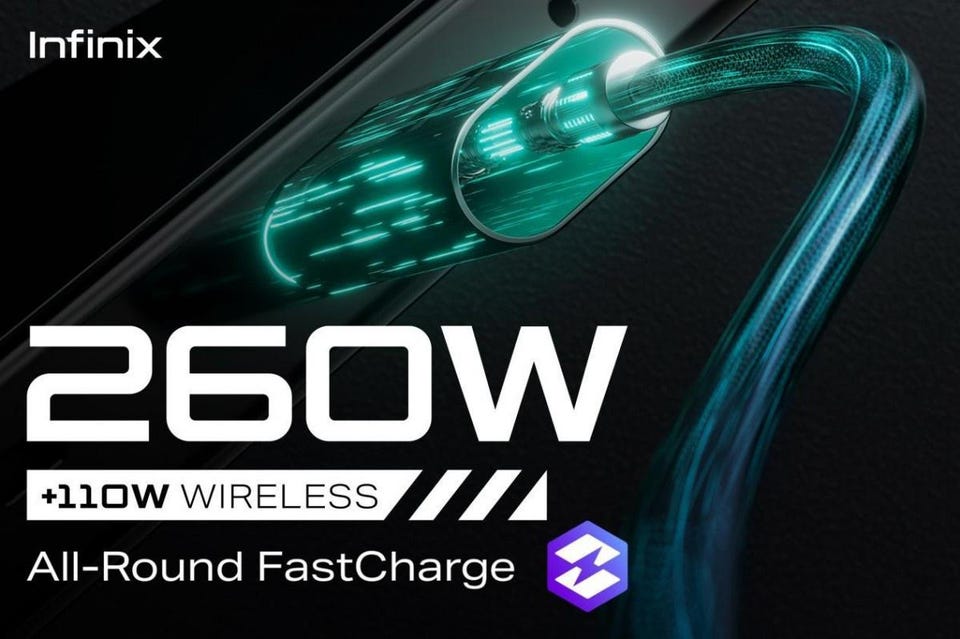Infinix’s 260W Fast Charging Can Fully Charge A Phone In Under 8 Minutes


Smartphones are such a dominant part of our lives these days that running out of power before we’re back home for the day can be very troublesome. While phone brands have made big strides in increasing battery capacity and improving battery usage efficiency, the reality is smartphones are also getting so powerful and capable that they command more power, and we in turn use them more. In 2023, I use my phone as not just my communication device, but also a camera, digital wallet, and remote control for an entire ecosystem of smart home products. In other words, phones have improved in battery life significantly in recent years, but our phone usage keeps ramping up, too.
So the best way to solve the so-called battery anxiety is still to have a phone that can charge faster. This is an area in which Chinese brands have been pursuing heavily, with Oppo and OnePlus starting the fast charging trend in the mid 2010s.
But the leader in this fast charging race right now is a little known brand named Infinix. It is also a Chinese company, but the brand has focused almost solely on the developing markets such as Africa and Latin America over the past few years. It actually doesn’t even sell in its home country. But Infinix’s new charging solution is here, and I’ve tried it, and it works. The video below shows me conducting the charging test in real time.
Infinix developed a 260W wired fast charger, and a 110W wireless charger. These only work with Infinix’s upcoming flagship phones, but the company sent me a prototype to try. The prototype device has a 4,500 mAh battery, and Infinix’s fast charger was able to top the phone from 0% to 77% in six minutes. I then switched over to wireless charging, and the phone topped up from 77% to 92% in three minutes.
Had I just kept the phone plugged in, it would have finished the 0 to 100% charge in under eight minutes. For comparison, it takes slightly over an hour to fully charge an iPhone 14 Pro, which has a smaller battery capacity than 4,500 mAh. Samsung’s Galaxy S23 Ultra, meanwhile, takes 80 minutes to fill up entirely. These numbers are using the absolute fastest possible chargers with the devices.

Some readers may be wondering what is the point of having charging this fast, and I agree it’s of no use most of the time. I usually charge my phones overnight when I’m sleeping, so it doesn’t really matter whether the charging period takes five minutes or five hours. But having extreme fast charging can be useful in specific emergency situations. For example, you may be about to head out for dinner just to realize your phone is very low on battery. Or you could be in the middle of a very long day out exploring a new city, and have just 5-10 minutes inside a coffee shop to top up your phone. In those situations, being able to charge your phone rapidly matters. With Infinix’s 260W solution, a mere three minute charge could bump enough battery into a phone to keep it going for several more hours. A three-minute charge on an iPhone would make no discerning difference.
I suppose the most important question to ask is: is this safe? Of course Infinix and other Chinese brands that have been pushing for faster charging speeds and some, such as Oppo, have been touting safety measures. Infinix, for its part, says in its press release that it has incorporated several safety precautions, including a chip that monitors charging, as well as “over 140-plus protection mechanisms and 20-plus temperature sensors.”
But I suppose we have to use the products ourselves over a long period of time to tell. I can say that I have been using fast charging tech from Oppo, Huawei and Xiaomi for years without issues, and I also follow the smartphone scene close enough that had there been incidents of a Chinese phone bursting into flames mid-charge, it would have surely made the news on tech websites and internet forums. I haven’t read any prominent news yet.
But still, Infinix is a much smaller company than Huawei or Oppo, so I understand if there are skepticism about safety protocols. As of now, readers should examine this fast charging technology from afar and wait maybe a year before adopting. Users can also choose not to use the fast charger unless they need to. So stick with normal charging for overnight charges, and only use the 260W charger when you are in need of a top up fast—and this thing is fast.
